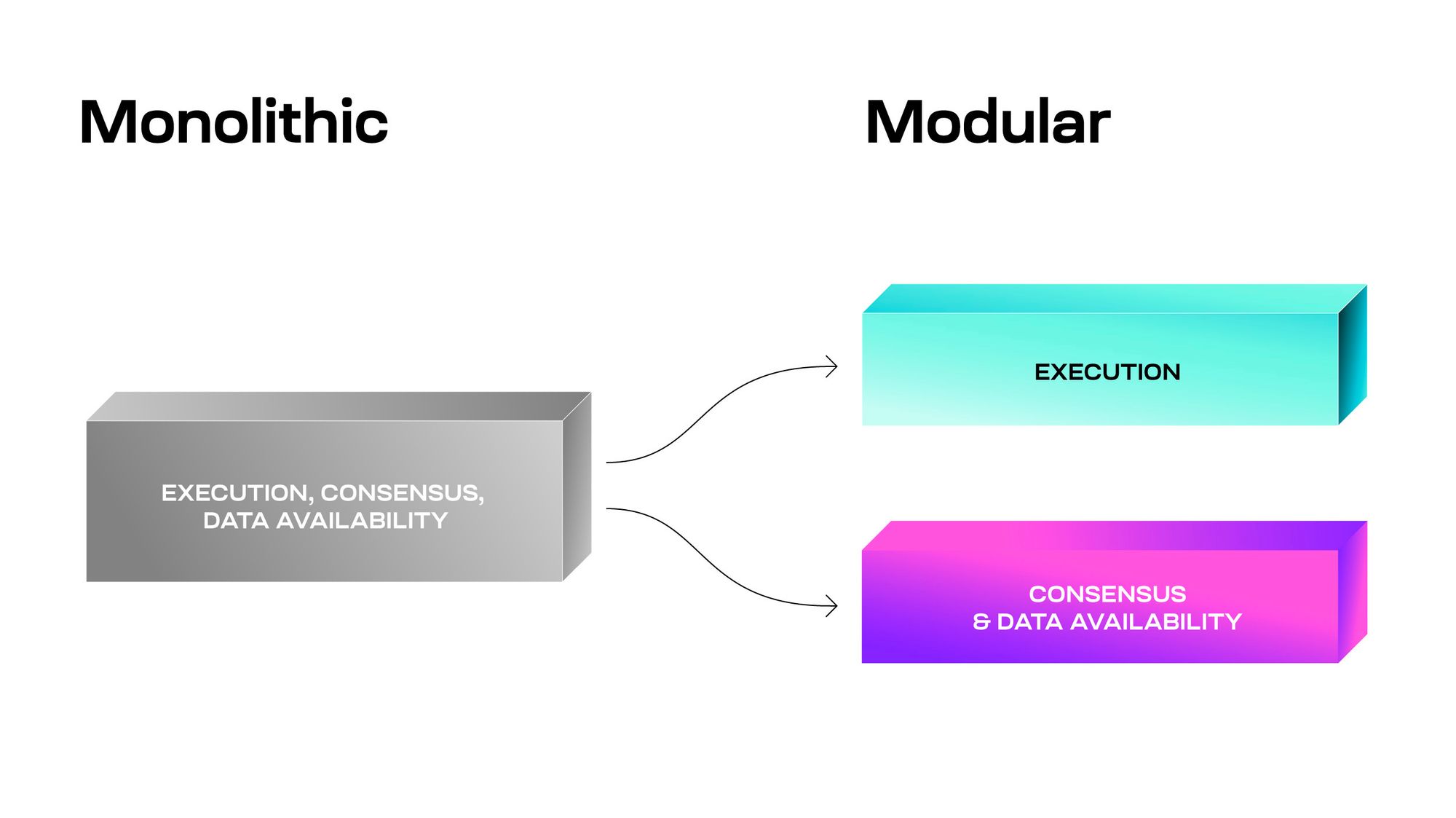Modular vs monolithic: a beginner's guide

You’ve probably heard it before. Celestia is the first modular blockchain network. But what is a modular blockchain, and how does Celestia fit into this? That’s what this post is all about - the brief version anyway.
TLDR
- The first approach to building blockchains was a monolithic design where a single blockchain does everything. However, the monolithic approach poses multiple problems.
- Modular blockchains are a departure from the monolithic approach by pursuing specialization. Namely, modular blockchains decouple consensus from execution.
- Modular blockchains optimize for a future of collaboration, flexibility, and sovereignty that strives for principles that empower people and communities first.
Modular blockchains
Monolithic blockchains were the first design approach to building blockchains. The idea being that a blockchain can do everything. That includes things like processing transactions, checking whether they’re correct, and getting nodes to agree on them. However, the monolithic approach causes some inherent problems with scaling while retaining the core principle of decentralization.
Modular blockchains are a fundamental shift from the monolithic approach to building blockchains. Instead of getting a blockchain to do everything, we can build blockchains that specialize in a few things. Mainly, modular blockchains introduce the notion of decoupling consensus from the execution of transactions. In practice, this means that one blockchain will be responsible for execution, while another will handle consensus.

Monolithic Problems
Because of the monolithic approach of trying to do everything, monolithic chains face a number of problems.
- High hardware requirements: Monolithic chains can increase the number of transactions they process, but it comes at a cost. That cost is higher hardware requirements for nodes to verify the chain.
- Bootstrapping validators: Deploying a new monolithic blockchain requires the overhead of bootstrapping a secure validator set and maintaining a consensus network.
- Limited control: Apps must follow the predetermined rules of the chain they deploy to. This includes the programming model, ability to fork, and community culture, among others.
High hardware requirements are a critical problem since the ability for users to run nodes is a fundamental part of blockchains. More expensive hardware means fewer users can run nodes to defend against attacks and verify that the chain is operating correctly.
Overhead in bootstrapping a new monolithic blockchain is high. Worse yet, security fragments since each chain has the task of building its own validator set. If we want an internet of blockchains, it is not feasible that each and every single one of them bootstraps its own security.
Deploying an app to a shared monolithic chain limits the community’s control over the app. Since the app doesn't own the chain, it can't make changes that are in its best interests. Losing sovereignty means limiting autonomy.
Benefits of modular
We know the problems that monolithic blockchains face, so what can modular blockchains do about them?
Shared security
Each time a new monolithic blockchain launches, a crucial part of the process is that they must bootstrap their own validator set. Unfortunately, it can be difficult to source a large enough validator set to become secure. Differences between chains leads to uneven security in an ecosystem of monolithic chains. A few will have high security with large validator sets, while many others will have low security with small validator sets. If we expect thousands of chains or more to make up the multi-chain ecosystem, we can’t expect each one of them to have enough security.
With shared security, deploying new blockchains like rollups doesn’t require bootstrapping a new validator set. Security is provided to blockchains by a common source, like Celestia. A new blockchain can deploy to Celestia and immediately tap into the security that it has built.

Since all chains deployed on Celestia receive even security from its validator set, there is no security fragmentation.
Let’s not forget that shared security also helps with building secure bridges. Celestia provides the data availability so blockchains can easily check if their transactions were published. Then, the connected blockchains can use proofs to secure the bridge and make sure transactions are correct.
It is shared security that provides a scalable and efficient way to bootstrap a blockchain ecosystem while enabling secure bridging.
Scalability
Remember, a core idea of modular blockchains is that they separate functions across multiple chains. This concept also brings extra scalability. A modular L1 like Celestia can now specialize in data availability. Without smart contracts, the L1 can focus all its resources on providing data for L2s, like rollups. Specialization is key because more data the L1 can provide allows rollups to process more transactions.
As for transactions, in the monolithic world, all apps live on the same chain. The downside is that users of different applications all have to compete to get their transactions processed. In the modular paradigm, apps live on separate chains. This means that a user of one app isn’t competing with the users of a different app for computation. So, transactions for many different apps can get processed at the same time.
Sovereignty
When an app is built on a shared monolithic blockchain, it is bound by predetermined rules. The rules might be around social consensus (when it's okay to hard fork) or around technical rules (what programming languages you can write smart contracts in).
Modular blockchains enable control over the rules of an application through sovereignty. Developers can make changes to the tech stack without permission from outside applications. For example, they could make a more performant execution environment or change how transaction processing works - who wants parallel transactions?
Importantly, sovereignty gives independence. Developers and the community can freely set the rules for their sovereign chain that aligns with their app and community’s ethos. It is sovereignty that places autonomy back in the hands of the community.
The monolithic route of silos
Let’s remove modular blockchains from the equation for a second. What does a future look like that is solely filled with monolithic chains?
It will still be multi-chain, because one monolithic chain will not have the capacity to handle all blockchain activity. A select few monolithic chains will have built up a large amount of security and validators, while significantly more chains will lack security - building security from scratch is still difficult.
In the process, each monolithic chain continues to build its own walled-off ecosystem. Fragmented tech causes friction for developers to move between ecosystems and clunky experiences for users. The L1 loop continues, fostering more maximalism among communities. Collaboration is missing when the fight for users is considered a zero-sum game.

Developers and users are tired. They want to build using blockchains with interoperable tech and a seamless cross-chain experience. The monolithic route has been tried and gone on long enough.
We need a future with modular blockchains.
The Modular Vision
That future we envision is one of collaboration, flexibility, and sovereignty. Developers can leverage existing modular infrastructure to deploy and maintain their new chain effortlessly. Users can access a modular blockchain network built to accommodate a seamless and secure cross-chain experience. Crucially, modular blockchains recognize the social power of their technology, adhering to principles that empower people and communities first and foremost.
Now is the time to break free from the status quo of monolithic blockchains. It is time to build modular.
